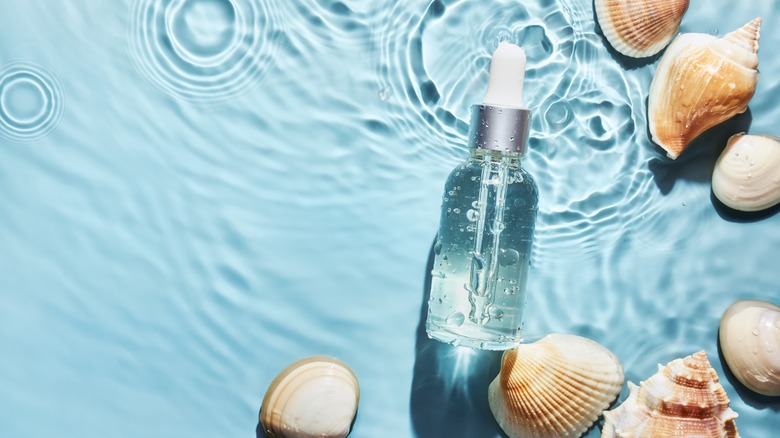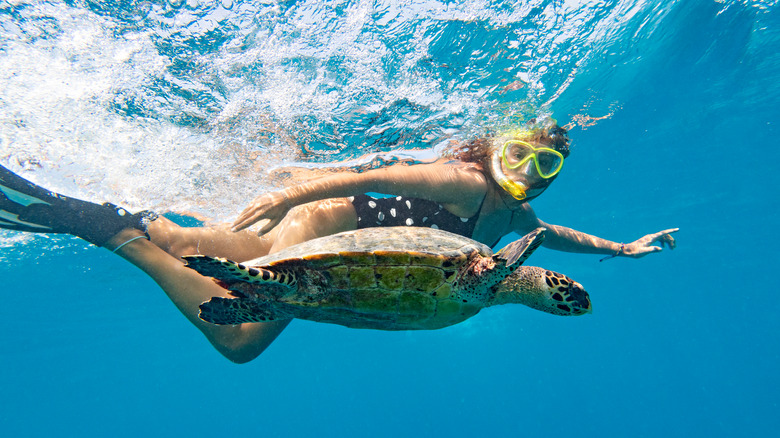What Is The Blue Beauty Movement?
As sustainability becomes more of a centralized focus in everyday products or actions, the beauty industry is no stranger to these efforts. You've heard of clean beauty, which emphasizes beauty products without toxic ingredients for both your health and the earth by leaving out the use of harmful chemicals. Green beauty, further adding to sustainability efforts, creates a focus on sourcing and producing beauty products in more ethical manners for the planet (via Clean Eating).
"Beyond sustainable packaging, every single relationship and element that is touched or moved to create a product is an opportunity for a sustainable or regenerative practice," Kypris founder Chase Polan tells CNN. Polan adds that there should be care for the land and the people from which the product comes from or is made. There should be carbon-minimizing efforts for the land, use of clean energy during production, and fair and healthy employment. While there are slight differences between clean and green beauty, it always comes down to ethical, sustainable practices. Now, a new movement is here, known as blue beauty. It enters the conversation with the same notion as other sustainable beauty brands: to care for all parts of the planet.
What is blue beauty?
Founder of Beauty Heroes, Jeannie Jarnot started the blue beauty movement in 2018. The basis of the movement is in sustainability to strive to make the planet better. While there are a variety of other sustainability efforts within green and clean beauty, blue beauty takes the same approach but with a specific focus on how it affects the ocean and marine life. "Blue Beauty is a sustainability movement specifically focused on reducing the negative impact of beauty products and packaging on our oceans and marine life," co-founder and C.E.O. of Kinship Christin Powell tells Ipsy. "It's about cleaning up our oceans by using reef-safe and ocean-safe ingredients, adopting a zero-waste policy and offering refillable and reusable packaging options."
Perhaps one of the most common manifestations of blue beauty has been seen in "reef safe" products such as sunscreen or haircare. According to Girls that Scuba, many chemical ingredients in products that are not reef-safe seep into the ocean water, in which they are then absorbed by the corals and other types of marine life that are negatively impacted. The growth and reproduction of these underwater life systems are disrupted, causing decreased fish fertility, corals dying off or being bleached, and disruption of algae photosynthesis. When ocean life is affected, the rest of the planet suffers too, as this affects the oxygen levels of the rest of the planet.
Why it matters
Because all water systems are interconnected, it's important to look at all of your everyday products. Think about your moisturizers, exfoliators, deodorants, hair products, cleansers, and more and where they will ultimately end up after you shower or wash it off. Not only are the chemicals unsafe for ocean life, but the packaging and its pollution take a toll as well, if not the biggest impact overall. "If nothing changes, there will be more plastic in the ocean than fish by 2050," founder of soap brand Petal, Jason Domangue tells Real Simple. "Americans throw away more than 30 million tons of plastic a year, and only eight percent get recycled. Personal care products contribute over 500 million plastic bottles to landfills and oceans every year." In fact, according to the International Union for Conservation of Nature, 98 million tons of plastic end up in the ocean every year, and 80% of ocean debris is plastic pollution found in both the surface and depths of the ocean. Both the chemicals and the plastic can be deadly to marine life. Blue beauty brands aim to tackle the problem.
"The key is to identify beauty products where the packaging is refillable or reusable for another purpose; support brand and retailer initiatives who encourage the return of packaging for recycling purposes and ensure that where packaging is unavoidable, it contains recycled materials as this can reduce the overall carbon impact," Sustainable Materials Specialist at WWF, Paula Chin tells ELLE. You can shop blue beauty from brands that prioritize sustainably and responsibly sourced safe ingredients, use recycled or recyclable materials, and have low or zero waste production.


